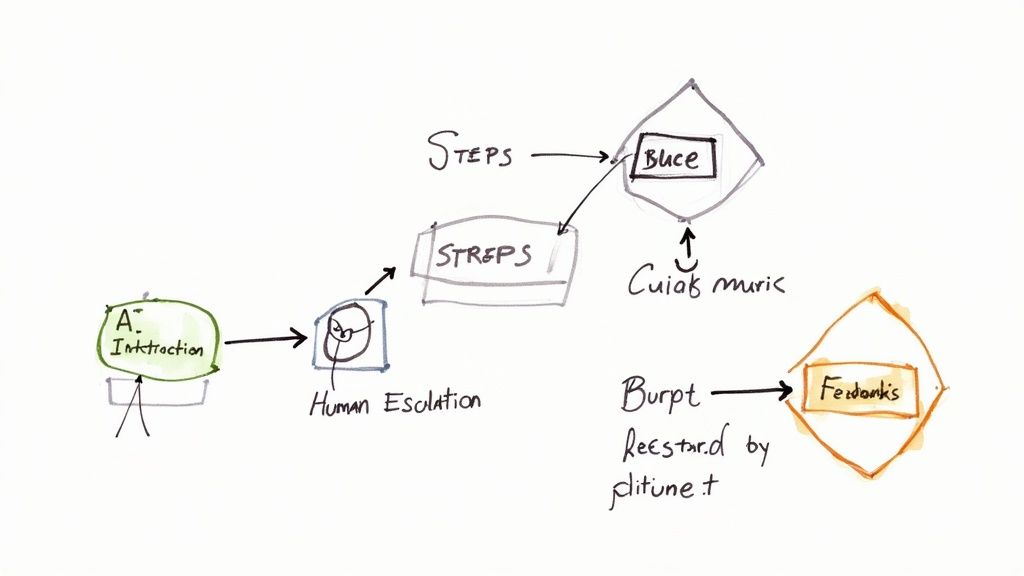Automate Customer Support: Pro Guide
The Real Impact of Support Automation

Customer support has fundamentally changed with the rise of automation. Companies now recognize that automated support systems aren't just a nice-to-have feature - they're essential for meeting modern customer expectations. The benefits are clear and measurable: businesses can now offer 24/7 support coverage that was impossible with traditional support teams alone. When a customer needs help at 3 AM, automated systems are there to assist, regardless of time zones or business hours. This constant availability helps build trust and keeps customers coming back.
Streamlining Operations and Enhancing Efficiency
Support automation has dramatically improved how support teams operate. Just like an efficient assembly line, automated systems handle the routine, repetitive tasks so human agents can focus on complex issues that need a personal touch. The numbers tell a compelling story - companies typically see up to 40% lower service costs after implementing automation. Support agents also become more productive, with studies showing they can handle 13.8% more inquiries per hour when using AI tools. These efficiency gains translate directly into faster response times and reduced operational costs.
Elevating the Customer Experience with Automation
The impact goes well beyond just saving money - automation makes support better for customers too. Quick answers to common questions mean customers aren't left waiting, and research consistently shows that faster responses lead to happier customers. Modern automation can also provide personalized help by analyzing customer data. When chatbots can access previous interactions and preferences, they create support experiences that feel tailored to each person. This personal touch helps customers feel valued and understood, making them more likely to recommend the business to others.
The Transformative Power of AI in Support
AI technology takes support automation even further. By analyzing support data, AI tools can spot trends and potential issues before they become major problems. For example, if an AI system notices multiple customers struggling with a specific feature, the support team can address it proactively. AI also remembers previous interactions - when a customer reaches out about a technical problem, the system instantly pulls up their history and product details, eliminating the need to explain everything from scratch. This combination of prediction and personalization points to a future where support becomes increasingly proactive and individually tailored to each customer's needs.
Building Your AI-Powered Support Framework
AI enables businesses to create an integrated support system that improves every step of the customer experience. By thoughtfully incorporating AI into your existing support operations, you can build an efficient framework that serves customers better. Learning from companies that have successfully implemented AI support can help guide your own automation journey.
Selecting the Right AI Solutions
Finding the right AI tools is essential for creating an effective support system. Each business has unique needs, so it's important to choose solutions that fit your specific requirements. Here are key factors to consider when evaluating AI options:
- Seamless Integration: The AI should work smoothly with your current CRM and support tools to minimize disruption during implementation
- Scalability: Choose solutions that can grow alongside your business and handle increasing customer volumes without performance issues
- Customization Options: Look for AI tools that can be adapted to match your brand voice and communication style
- Robust Analytics: Select platforms that provide detailed performance data so you can track results and keep improving
For instance, an online store might focus on finding a chatbot that works well with their website and customer database, while a large company may need more advanced AI capabilities for data analysis and process automation.
Implementing AI for Maximum Impact
Getting the most from AI requires careful planning and execution. Start by defining clear goals - do you want to speed up response times, boost customer satisfaction, or make internal processes more efficient? Having specific targets helps guide implementation decisions.
Look for areas where AI can make the biggest difference right away. Common starting points include automating simple requests like password resets and order tracking. This allows your support team to focus on complex issues that need a human touch. Recent data shows AI chatbots can now handle up to 80% of routine customer questions. This means your staff can spend more time building relationships and solving challenging problems.
Keep monitoring results and refining your approach after launch. Regular data analysis helps identify what's working well and what needs adjustment. Think of implementation as an ongoing process of improvement rather than a one-time project. Take inspiration from companies like AkzoNobel, who significantly reduced response times through strategic AI use.
Learning From Success Stories
Real examples from other businesses provide valuable insights for your own AI support journey. Companies like HelloFresh have shown how automation can reduce incoming questions while improving customer satisfaction and service speed. Studying these cases helps highlight effective approaches and potential challenges to watch for.
Remember that every company's situation is different - what works for one may not work for another. The key is adapting successful strategies to fit your specific needs, customer base, and existing systems. With a well-designed AI support framework, you can create an efficient system that delivers personalized service to every customer while controlling costs.
Maximizing Returns While Maintaining Quality

Getting customer support automation right requires carefully balancing cost reduction with service quality improvement. Smart companies focus on implementing solutions that work for both their bottom line and their customers' needs. Many businesses are already seeing major cost savings alongside higher customer satisfaction scores. Understanding how to measure and boost the return on your automation investment is key to achieving similar results.
Calculating and Optimizing Your Automation ROI
When measuring the ROI of support automation, you need to look beyond basic cost comparisons. For instance, consider how automation frees up your support team's time. AI chatbots can now handle up to 80% of common requests like password resets and order tracking. This allows your agents to focus on complex issues that need a human touch. Research shows agents can process 13.8% more inquiries per hour with automation support.
The numbers tell an even more compelling story when you factor in key performance metrics. Current studies show automation can cut response times by up to 50% and resolution times by 30%. These improvements directly boost customer satisfaction, leading to stronger customer loyalty and more referrals. These long-term benefits significantly impact your automation ROI beyond the immediate cost savings.
Strategies for Scaling Support Operations
As customer demand grows, your support system needs to keep pace without dropping service levels. Sitebot offers an effective solution by letting you build and deploy AI chatbots that match your brand and content needs. The platform works smoothly with tools like Slack and Zendesk, making it easier to handle increased volume without major staffing changes.
Good scaling also requires consistent performance tracking. By monitoring metrics like customer satisfaction scores, resolution speed, and agent productivity, you can spot what's working and what needs adjustment. This data helps you identify bottlenecks and fine-tune your automation setup. For example, if certain support processes are slowing things down, you can adjust your workflows or reallocate your resources accordingly.
Maintaining Service Quality During Growth
Growing your support operations shouldn't mean losing the personal touch. While automation handles routine tasks, keeping human involvement for complex issues is essential. Train your support team to handle escalated cases effectively when automated systems can't provide a solution. This ensures customers with unique problems get the focused attention they need.
Quality maintenance also means regularly checking and updating your automated systems. Your automation approach should evolve as your business does. Pay attention to performance data, listen to customer feedback, and adjust your strategy to meet changing needs. Regular refinements to your automation setup help ensure every customer gets great service, no matter how much your business grows.
Creating the Perfect Human-AI Balance
Finding the right mix between automated and human customer support is key for delivering excellent service. While automated systems are great at handling routine questions and tasks, human agents bring essential qualities like empathy and judgment that machines can't replicate. The goal is to thoughtfully combine both approaches to handle customer needs efficiently while keeping service personal and caring.
Identifying Automation Opportunities
Start by looking at which customer interactions make the most sense to automate. Common examples include answering basic questions, helping with password resets, checking order status, and scheduling appointments. An AI chatbot can instantly tell customers where their package is or walk them through account access steps, which lets human agents focus on more complex issues. For instance, when customers need detailed technical help or have sensitive complaints, they'll get direct attention from a real person who can fully understand their situation. This smart division of tasks helps everyone - customers get quick answers for simple needs and personal support when it matters most.
Empowering Human Agents with AI
Rather than replacing human agents, AI tools help them work better. By handling routine questions automatically, AI frees up agents to spend time on challenging issues that need their expertise. This includes solving tricky technical problems, turning around upset customers, suggesting personalized product options, and building strong relationships with key accounts. Think of AI as handling the basics while human agents focus on skilled, high-value support. AI also helps by giving agents quick access to customer history and insights, so they can provide more informed and personal service in every conversation.
Maintaining Empathy in Automated Interactions
While automated systems excel at efficiency, keeping them feeling warm and personal takes careful planning. One key approach is setting up smooth handoffs to human agents whenever situations call for a personal touch. This might happen when the system spots phrases showing frustration like "This isn't working" or "I need help now." Making these transitions feel natural helps customers know they're being heard and understood, even when talking to an automated system first. It's also important to regularly update the AI's language to sound more caring and human. This can include adding phrases that acknowledge feelings or offering genuine apologies when things go wrong.
Training for the Human-AI Partnership
Getting the most from AI support tools takes more than just installing new technology - it requires preparing your team to work effectively alongside these systems. This means teaching agents what AI can and can't do, showing them how to use AI tools effectively, and preparing them to handle the complex conversations that need human skills. Training might cover how to read AI-provided customer data, smoothly take over from chatbot conversations, and use AI insights to give more personal service. When teams understand how to partner with AI effectively, they can deliver both efficient and caring support that meets all kinds of customer needs.
Measuring What Really Matters

When it comes to automated customer support, success depends on more than just setting up the system - you need to track the right metrics to ensure it's actually delivering value. While reducing costs is important, the real measure of success is whether your automation improves both the customer experience and makes your support team more effective. Let's look at how leading companies measure and optimize their support automation.
Key Performance Indicators for Automated Support
The best way to evaluate your automated support is to track key metrics across different areas that show how well the system serves customers and empowers agents. Simply looking at cost savings doesn't tell the whole story - you need a complete view of performance. Here are the essential metrics to monitor:
- Customer Satisfaction (CSAT): This directly shows if customers are happy with the support they receive. Send quick surveys after chatbot interactions to gather feedback. High CSAT scores mean your automated system is doing its job well.
- First Response Time (FRT): Customers expect quick replies when they reach out for help. FRT measures how fast they get an initial response. AI chatbots can cut response times in half compared to manual support, which makes a big difference in customer happiness.
- Resolution Time: Beyond that first reply, customers want their problems solved quickly. Resolution time tracks how long it takes to fully address each issue. Good automation typically reduces resolution times by 30% by helping agents work more efficiently.
- Agent Productivity: When routine tasks are automated, support staff can focus on complex problems that need a human touch. Track metrics like tickets handled per hour - studies show agents using AI tools can handle 13.8% more inquiries.
- Automation Rate: This shows what percentage of customer interactions are handled completely by automated systems. For basic requests, top companies can automate up to 80%, freeing up agents for more valuable work.
Setting Up Actionable Measurement Systems
Collecting data only helps if you use it to make improvements. Your measurement system should give you clear insights you can act on. For example, if satisfaction scores drop for certain chatbot conversations, dig into the customer feedback to find out why. Here's how to organize your key metrics:
| KPI | Measurement Method | Actionable Insights |
|---|---|---|
| Customer Satisfaction | Post-interaction Surveys | Identify areas where the automated system is failing to meet needs |
| First Response Time | System Logs | Pinpoint bottlenecks in the automated response process |
| Resolution Time | System Logs | Optimize workflows to streamline issue resolution |
| Agent Productivity | Number of Inquiries Handled | Evaluate the impact of automation on agent workload |
| Automation Rate | System Logs | Identify opportunities to automate more interactions |
By regularly checking these metrics and making data-driven improvements, you can fine-tune your automated support to work better for both customers and agents. Focus on the numbers that matter most for delivering excellent service efficiently.
Future-Proofing Your Support Strategy

Customer needs and support technologies keep changing, making it essential for companies to plan ahead. Successful businesses understand that meeting current customer needs isn't enough - they must also prepare for what's coming next. This means testing new approaches, staying flexible, and always putting customers first to build support systems that stand the test of time.
Adapting to Evolving Customer Expectations
Today's customers want more than just basic support - they expect quick, personal responses no matter how they reach out. Social media, messaging apps, and email have trained people to expect fast answers within minutes or hours, not days. Companies need reliable support across all these channels while maintaining quality and speed. Customers also want to feel like more than just a ticket number - they want support agents who understand their history and needs. This means using smart tools that can pull up relevant customer data to provide better, more informed help. Support teams are starting to use AI tools that can spot patterns in customer behavior to offer more helpful, customized assistance.
Embracing New Automation Technologies
Smart companies regularly test new ways to make support more efficient without losing the personal touch. Modern chatbots powered by AI can now handle many common questions, freeing up human agents for more complex issues. Data analysis tools can spot potential problems before they become major headaches for customers. But automation isn't just about chatbots - it can also help route tickets to the right team members and keep workflows moving smoothly. The real skill is knowing when to use automation and when human interaction works better. The goal is creating seamless support that combines the best of both worlds.
Maintaining Flexibility and Avoiding Pitfalls
Building support that lasts requires staying adaptable as things change. Instead of rigid systems, companies should choose flexible tools that can grow and change with their needs. As your business expands or customer preferences shift, your support setup should adjust smoothly without major disruptions. Watch out for common mistakes like relying too heavily on automation or forgetting the importance of human connection. Great support finds the right mix of efficient automated help and genuine human assistance. Keep tracking what works, listen to customer feedback, and be ready to adjust your approach to stay effective.
Ready to build a chatbot tailored to your specific needs and integrate it seamlessly into your existing platforms? Check out Sitebot today to transform your customer support with the power of AI.


